
Gradually about all

Some are certain that ball lightning is endowed with reason Many believe it is necessary to behave with it as well as with a malicious dog...

Is that really so?
In this New Year's issue we continue the subject of the threadlike substance fireball and offer some experimental data - videorecording with moderate calculations allowing as it seems to us to clear given question. The last has also practical importance - to promote decrease of fireball lesion probability.
Transition of a fireball to the dynamic state.
We chose the experiment which does not impress with fireball parameters characterizing its size, lifetime or the caused damage, but it is carried out under conditions already having been considered above and consequently known to the reader, as against the "closed" discharge allows visually or with the help of video to look through all stages of process and at last, that's the most important, reveals the phenomenon constituting the name of article with an opportunity to take necessary measurements.
So, let us revert to
the high-voltage low-current electric discharge under the surface of the liquid paraffin. Sometimes its uniform course is broken, accompanied by a breaking off of a current and by ejection of autonomous luminous object. Videorecording of one of variants is given on fig. 1 at format 180x144 (Slideshow 720x576 - 1.3 MB).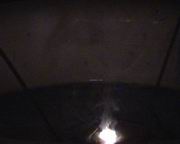
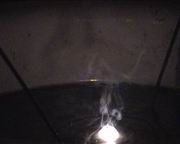
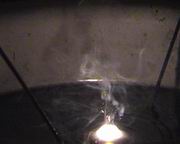
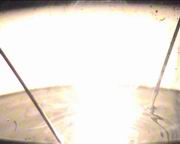
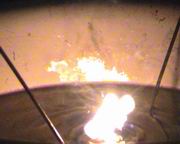
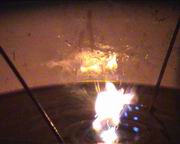
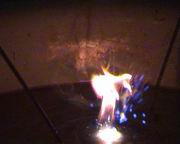
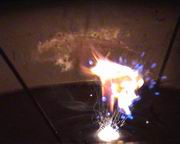
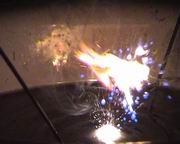
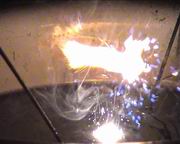
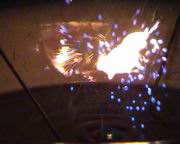
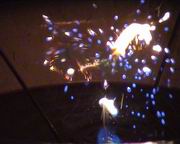
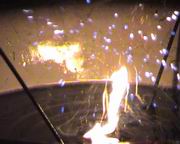
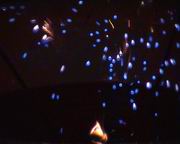
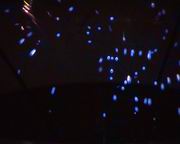
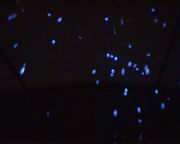
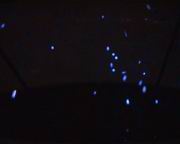
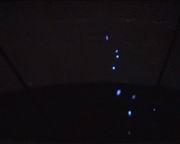
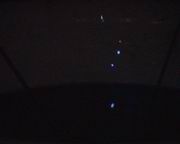
The existent events can be imagined as follows. At the time of first three frames the bubble filled with nonideal plasma on the basis of evaporated paraffin and threads distributed in it is formed under electrical discharge conditions. After the bubble's surfacing the nonideal plasma throws oneself out into atmosphere, refrigerates, reduces its luminosity and takes the form close to spherical one deformed by inceptive burning (three more frames). At the time of next seven frames under the influence of condensation with burning the object widens fast and divides into multitude of small blue balls by diameter about 1mm. In most cases the blue balls are overloaded with paraffin, fall and have usual aerodynamics. Falling on object-plate they show a drop of paraffin with clew of threads frozen in its centre.
However some of them behave completely differently. After the appearance they can be still and then begin movement including upwards and even with the big acceleration. Last six frames, at the time of which rather bright luminescence of nonideal plasma is already absent, are presented at fig.2 as joint image (
slideshow 180x144). We have detached in it identical parts of full frames with several objects having shown abnormal aerodynamics.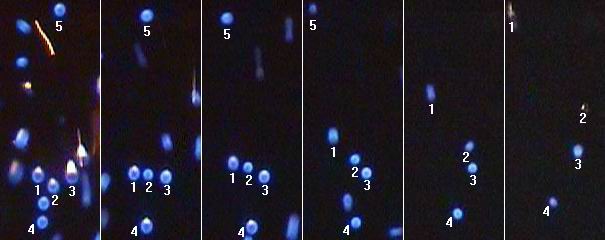
These objects differ by presence of rather dark internal part and by ability for generation of bright zone in the top part which can give rise to the child object separating from the parent one with an acceleration (object 3).
What nature of their movement? Isn't it possible to represent they as thin-wall spheres-bubbles of the metal-containing polymer filled with light gas - hydrogen which just float in the atmosphere?
To answer this question we shall recollect the law of such movement and receive upper bound for the maximal speed of ascension and then compare them with law of motion and final speed of the object 1 having been most accelerated. Two forces are applied to the floating ball: buoyancy force being equal to weight of displaced air and ascent resistance force which can be described via Stokes force because of small values of ball's radius and speed.
At first the resistance is small, and the ball begins motion with constant acceleration so its vertical coordinate grows according to the square-law. Acceleration gradually falls, and at the steady-state motion two mentioned forces are in balance so the upper estimate of the maximal speed can be got in approximation of zero weight of the ball as:Vmax<2gr2
r/9hwhere
g - gravitational acceleration, r - air density, r - ball's radius, h - air viscosity. It doesn't exceed Vmax < 0.04m/s while speed of object 1 at the last frame ~0.5m/s!Now we shall give relative values of vertical coordinate Y of object 1 at six frames under supposition of equality of its values to zero at the first frame and to unit at the second one. In brackets values of function
n2.72 are given at n=0,1,2,3,4,5.Applying power function to the motion path approximation one can receive the height-time relationship for object 1:
Y=0.25mm(t/0.02s)2.72. Then speed is:V=34mm/s(t/0.02s)1.72, and speed at last sixth frame of fig.2 is: V5=542mm/s, while acceleration is: a=2924mm/s2(t/0.02s)0.72, and a5=9.3m/s2, though a1=2.9m/s2 and a0=0.Let's specify the main thing: acceleration doesn't fall but grows because index of approximation power is more than two, and speed is order greater than maximal speed of ascension no, it is no just floating bubble filled with hydrogen!
It looks as if the objects with abnormal aerodynamics have tractive force increasing with growth of the motion speed, and they use the substance as fuel. A ramjet engine has similar properties: under zero velocity the traction is absent, and the operative mode needs the speed in several Machs, self-dependent launching of apparatus with such engine is impossible. Then why the ball lightning usually if doesn't stand still, flies with much smaller speed? Probably the answer to this question is hidden behind small value of dust sound speed, however, it is only the assumption.
In our opinion, the fireball is present always at the ball lightning which is in the active state irrespectively of its nature: plasma - chemical, plasma, plasma - nuclear. It is possible to imagine some variants of a " fireball's ramjet engine" construction: Á - inverted at which the role of a diffuser plays a body of the fireball, b - under the insufflation of its threadlike substance (electrochemical kinetic effect in aerodisperse system under burning conditions), this variant is interesting both for the considered experiment, and to an explanation of the electromagnetic pulse at explosion of a fireball, of oscillations in erosive discharges, of the protracted lightning discharges which are not blown off by a strong wind (one of such cases, as we recall, was fixed at the TV tower in Ostankino), of lightning emissions into upper atmosphere and of weather formation, þ - vortical, especially interesting in the cases of a plasma ball lightning modelling and waves of nuclear burning in depths of stars however we shall return You to a question on similarity of behaviour of malicious fireballs and dogs.
In view of stated it is obviously that the careless movement near a ball lightning can cause a stream of air to it and make active its motion to the Source. As acceleration can be about "g" the time of achievement of the "purpose" can be a split second as well as in a case with a dog, though having only physical nature this effect can not be the justification to endow a ball lightning with reason.
There is a statement that to avoid direct contact to a coming nearer ball lightning it is necessary to blow onto it, and as it has a great windage it will be simply blown off... Actually the stream of air can " launch its ramjet "! To find out where in such case it will find itself with the greatest probability and for rather short time we leave to the author of this statement as one of his
New Year's Home Exercises

Happy New 2005 Year!